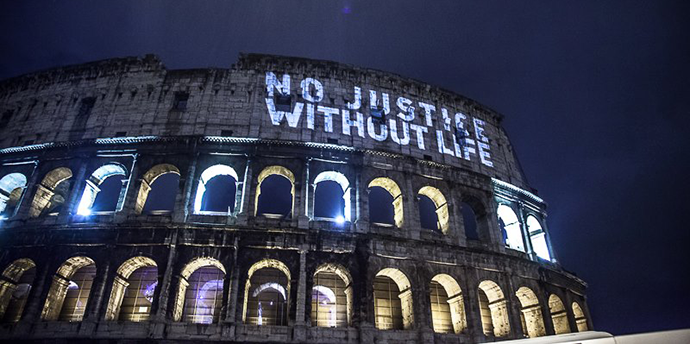On Sunday, November 30, more than 1800 cities in more than 90 countries will specially illuminate one of their monuments. This is a part of the international manifestation “Cities for Life – Cities Against the Death Penalty”, which has, for fourteen years, been initiated by the Community of Sant’Egidio, in cooperation with numerous human rights organizations, joined in the World Coalition Against the Death Penalty. In this symbolic manner, cities show that they oppose the death penalty as a barbaric institution, and that they support the inherent and inalienable human right to life. On that day, apart from illuminating a monument, city authorities and NGOs organize cultural events dedicated to the abolition of the death penalty. The date was chosen because on November 30, 1786, the death penalty was abolished for the first time in a sovereign country, the Grand Duchy of Tuscany.
Belgrade participated in this event on three occasions – in 2007, 2012 and 2013. City authorities chose to illuminate Cukur cesma, while NGOs Center for Peace and Democracy Development (2007), and, later, Serbia against the Death Penalty (member of the World Coalition) organized different manifestations – a round table, a walk through the city or a theatre play.
This year, Serbia against the Death Penalty wrote a letter to the city authorities – the Mayor and the President of the City Municipality – proposing that Belgrade once again participates in the manifestation Cities for Life. No one deemed this letter important enough to warrant a reply. Why? In part, because people who are currently in power in Belgrade aren’t aware that basic decency dictates that they should at least answer – these rules of behavior were not part of their upbringing. Additionally, because people like them consider letters and writing as an expression of feebleness: those with power and influence do not write letters, they make a phone call. But, for the most part, because general ethical issues fall outside their reach. They cannot understand why anyone would be concerned about the fact that, in certain parts of the world, courts impose death penalties on living people and government officials then execute these people – what does that have to do with them? Finally, there is a certain amount of atavistic fear of “the foreign world”. In that world some cities illuminate monuments just like that, while their citizens tackle issues that have no practical meaning. This, in part, resembles the reaction of Serbian authorities to the solar eclipse on August 11, 1999. On that day, hundreds of millions of people around the world viewed the eclipse in a carnival-like atmosphere filled with happiness and joy, while Serbs, instructed by their authorities, hid behind closed curtains and kept their children indoors.
The Mayor and the President of the City Assembly couldn’t care less that, for the last ten years, according to public opinion polls, citizens of Belgrade have been more often opposed to the death penalty than in favor of it. They cannot see the connection between the participation of Belgrade in the Cities for Life manifestation, on the one hand, and, on the other, the fact that death penalty in Serbia is prohibited by the Constitution and that Serbia has agreed, by signing numerous international treaties, to oppose it. They do not know that, when Belgrade illuminates a monument, it appears on a world map. They do not want Belgrade in the world, but want it for themselves, in darkness if possible.
Truth be told, the current city authorities are not much different from their predecessors in this respect. When the previous city governments chose to illuminate a monument (in 2007 the Mayor was Radmila Hrustanovic; in 2012 and 2013 Dragan Djilas), they did so with reluctance and shyly, more out of personal regard for certain opponents of the death penalty than out of conviction. Not one representative of the city ever appeared in public on November 30, let alone said something. The word was that Dragan Djilas personally supported the death penalty, and thus his associates did not want to go overboard showing their enthusiasm. The most the city did in those years was to instruct some technician from the Electric Power Company to install an additional spotlight on Cukur cesma.
Bitter truth be told, citizens of Belgrade, although they have been claiming for a while to be against the death penalty, haven’t exactly excelled in this regard. This year, following the moral panic which ensued after the rape and murder of an underage girl, the majority of polled citizens of Belgrade, for the first time, were in favor of the death penalty. Belgrade is, after all, a part of Serbia: at the peak of this year’s moral panic, the Facebook profile “Death penalty for the murderer of Tijana Juric” had over 180.000 likes, while the profile “Serbia against the death penalty” has, on this day – 1.349.
The abolition of the death penalty is a civilizational achievement which, like many others, we have imported from the “foreign world”. Furthermore, it was adopted under pressure, because in 2002, it was a condition for Serbia (that is, FRY) to join the Council of Europe. However, once we have adopted it, we have the obligation – the authorities most of all – to look after it, to honor it and improve it. One of the ways is to illuminate a monument each November 30, to speak and think of the people around the world who are facing the possibility of a death sentence, and to actively oppose the demands to reintroduce the death penalty because of the tragic death of a young girl. The previous city authorities, which chose to illuminate Cukur cesma, if without any enthusiasm and against their convictions, appeared to be aware of this fact. The current authorities seem to believe that looking after civilizational achievements is the foreign world’s job, not theirs.
Translated by Bojana Obradovic
Peščanik.net, 02.12.2014.



